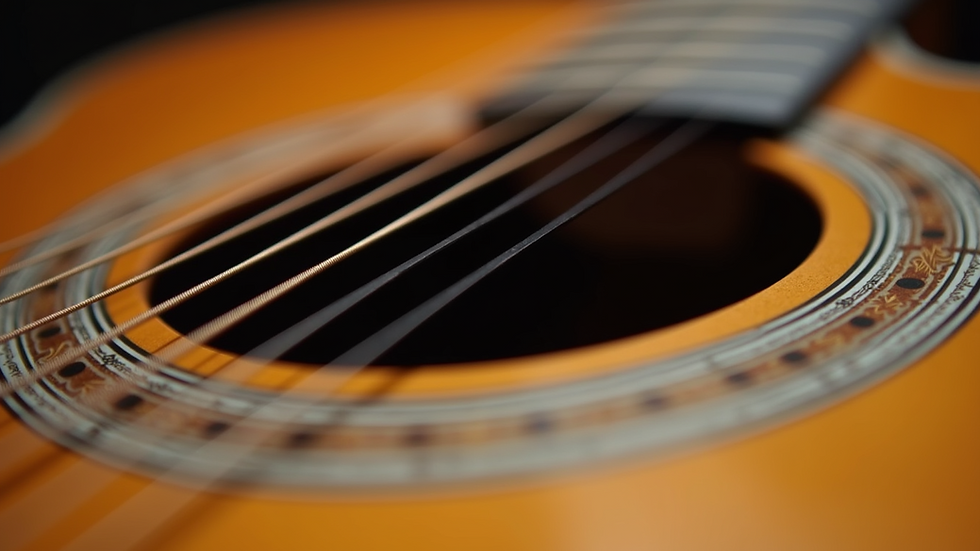Essential Elements for EQing an Acoustic Guitar to Achieve Optimal Sound Quality
- nicolas Essig
- Aug 17
- 4 min read
Updated: Sep 4
Are you struggling to get the perfect sound from your acoustic guitar recordings? Many musicians and audio engineers face this challenge. The acoustic guitar is a flexible instrument, but its natural tonal qualities can sometimes cause issues, like muddiness or lack of clarity. This is where equalization (EQ) comes in as a powerful tool. With it, you can shape your guitar's sound and make sure it fits smoothly into your mix. In this post, we will dive into five essential elements for effective EQing of an acoustic guitar.
High-Pass Filter (HPF)
One of the first steps in EQing an acoustic guitar is to apply a High-Pass Filter (HPF). This filter is crucial for cutting out low-end rumble and muddiness, especially within the 80 Hz to 120 Hz range. Many acoustic guitars capture unwanted low frequencies that clutter the mix. An acoustic guitar track without an HPF can show excessive low-end buildup, making it hard to distinguish other instruments.
For instance, if you are mixing a song with drums, bass, and keyboards, applying an HPF will not only clean up the low end but also create room for those instruments to shine through. A well-used HPF allows the acoustic guitar to stand out, improving clarity and definition.
Low-Mid Cut
Acoustic guitars often have frequencies that can create a "boxy" sound in the 200 Hz to 400 Hz range. This buildup can detract from the instrument's overall clarity. A gentle cut in these low-mid frequencies can make a substantial difference.
Consider applying a reduction of about 2 to 4 dB at the problematic frequencies. This approach helps maintain warmth while clearing up muddiness. For example, if you notice a lack of definition in an acoustic track, this adjustment can help to make it appear more present in the mix, ultimately enhancing your overall sound.
Clarity and Presence Boost
To make your acoustic guitar stand out, boosting the upper-mids—specifically in the 1 kHz to 5 kHz range—is key. This range emphasizes the string attack and overall character of the instrument. By making a small, focused boost here, you can turn a dull sound into a lively one.
However, balance is critical. Over-boosting can lead to a harsh sound. Instead, aim for subtle adjustments. For instance, a 3 dB boost might be all you need to bring your acoustic guitar forward in the mix without sacrificing its warmth. Thoughtful boosting in this range can be the difference between a plain sound and an engaging one.
Air and Sparkle Boost
High frequencies, typically above 6 kHz, contain the "air" and "sparkle" that brings an acoustic guitar to life. A gentle boost in this area can make the instrument sound more open and vibrant. This enhancement allows the acoustic guitar to cut through a dense mix without sounding muted.
As you boost these high frequencies, be cautious not to overdo it. A 1 to 2 dB boost is often sufficient to achieve that desirable openness without compromising warmth. For example, if you are mixing a ballad, enhancing the air can help the guitar sound more inviting while still allowing it to blend naturally with vocals.
Notch Filter for Resonant Frequencies
While mixing, you may notice certain unpleasant resonant frequencies that poke out too much. These can make the guitar sound unbalanced and harsh. Using a notch filter is a brilliant way to tame these specific frequencies.
To pinpoint these troublesome frequencies, slowly sweep a narrow boost through the spectrum until you identify the unwelcome sound. Once found, applying a narrow cut to lessen its prominence can significantly improve the overall tone of the guitar. For example, if you discover a resonant frequency around 300 Hz, a 3 dB cut can balance the sound and enhance the overall quality.

Additional Tips for EQing Acoustic Guitars
Understanding Your Mix
Before diving into EQ adjustments, take a moment to listen to your entire mix. Understanding how the acoustic guitar interacts with other instruments is crucial. This awareness will guide your EQ decisions.
Experiment with Different Settings
Don't hesitate to experiment with different EQ settings. Each acoustic guitar is unique, and what works for one may not work for another. Trust your ears and make adjustments based on what sounds best in your mix.
Use Reference Tracks
Listening to reference tracks can provide valuable insights. Compare your acoustic guitar sound to professionally mixed tracks. This practice can help you identify areas for improvement.
Trust Your Ears
Ultimately, trust your ears. If something sounds off, it probably is. Make adjustments until the acoustic guitar fits seamlessly into your mix.
Wrapping Up
EQing an acoustic guitar is an essential skill for musicians and audio engineers who want to achieve high sound quality. By implementing these five elements—using a High-Pass Filter, making a low-mid cut, boosting clarity and presence, enhancing air and sparkle, and utilizing a notch filter—you can significantly improve the sound of your acoustic guitar.
Keep in mind, the goal of EQing is to enhance the instrument's natural qualities and integrate it seamlessly with other elements in the mix. With practice and keen listening, you can master the art of EQing acoustic guitars, elevating your recordings and performances to new heights.




Comments